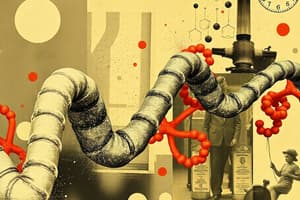Podcast
Questions and Answers
Which type of protein is responsible for catalyzing biochemical reactions?
Which type of protein is responsible for catalyzing biochemical reactions?
- Defensive proteins
- Enzymes (correct)
- Structural proteins
- Transport proteins
What level of protein structure is characterized by the unique sequence of amino acids?
What level of protein structure is characterized by the unique sequence of amino acids?
- Primary structure (correct)
- Quaternary structure
- Secondary structure
- Tertiary structure
What is the effect of denaturation on protein structure?
What is the effect of denaturation on protein structure?
- It has no impact on protein folding.
- It leads to the loss of 2° or 3° structure. (correct)
- It increases the stability of the quaternary structure.
- It enhances the protein's function.
Which amino acid is specifically noted for causing kinks in the polypeptide structure due to its unique side chain?
Which amino acid is specifically noted for causing kinks in the polypeptide structure due to its unique side chain?
What interactions are crucial for maintaining protein folding beyond the primary structure?
What interactions are crucial for maintaining protein folding beyond the primary structure?
What role do functional groups in amino acids play in protein activity?
What role do functional groups in amino acids play in protein activity?
Which statement correctly describes the classification of amino acids?
Which statement correctly describes the classification of amino acids?
What defines the primary structure of a protein?
What defines the primary structure of a protein?
What is the significance of the L-form of amino acids in biological systems?
What is the significance of the L-form of amino acids in biological systems?
How do changes in environmental conditions, like pH, affect amino acids?
How do changes in environmental conditions, like pH, affect amino acids?
What causes the reduced oxygen-carrying capacity in sickle-cell hemoglobin?
What causes the reduced oxygen-carrying capacity in sickle-cell hemoglobin?
Which amino acid substitution is associated with sickle-cell hemoglobin?
Which amino acid substitution is associated with sickle-cell hemoglobin?
What is the typical diameter of a normal red blood cell?
What is the typical diameter of a normal red blood cell?
What is a characteristic of denaturation in proteins?
What is a characteristic of denaturation in proteins?
What leads to the formation of abnormal hemoglobin fibers in sickle-cell anemia?
What leads to the formation of abnormal hemoglobin fibers in sickle-cell anemia?
Flashcards
What are amino acids?
What are amino acids?
The building blocks of proteins, linked together by peptide bonds.
What are functional groups?
What are functional groups?
Groups of atoms within a molecule that determine its chemical properties and reactivity. In amino acids, they are found as side chains and contribute to protein function.
What are the 20 standard amino acids?
What are the 20 standard amino acids?
The 20 different amino acids that are used to build proteins in living organisms.
What does it mean that amino acids are amphoteric?
What does it mean that amino acids are amphoteric?
Signup and view all the flashcards
What are stereoisomers/enantiomers in amino acids?
What are stereoisomers/enantiomers in amino acids?
Signup and view all the flashcards
Primary Structure
Primary Structure
Signup and view all the flashcards
Secondary Structure
Secondary Structure
Signup and view all the flashcards
Tertiary Structure
Tertiary Structure
Signup and view all the flashcards
Quaternary Structure
Quaternary Structure
Signup and view all the flashcards
Denaturation
Denaturation
Signup and view all the flashcards
Sickle-cell anemia
Sickle-cell anemia
Signup and view all the flashcards
Sickle-cell hemoglobin
Sickle-cell hemoglobin
Signup and view all the flashcards
Protein denaturation
Protein denaturation
Signup and view all the flashcards
Protein renaturation
Protein renaturation
Signup and view all the flashcards
Normal hemoglobin
Normal hemoglobin
Signup and view all the flashcards
Study Notes
Amino Acids and Proteins Introduction
- Amino acids are the building blocks of proteins
- Amino acids are linked together by peptide bonds
- Functional groups on amino acid side chains determine protein activity
- There are 20 amino acids
- Amino acids can be electrically charged, polar, or nonpolar, depending on the side chain
- Side chains affect how proteins behave in different environments
- Amino acids differ in their behavior depending on pH
Objectives
- Compare and contrast the chemical and structural features of amino acids to understand how they contribute to protein behavior. This will focus on functional groups
- Explain how side chains on amino acids affect behavior and function
- Explain the formation of peptide bonds and their relationship to protein function
- Evaluate protein structures:
- Identify and describe the different levels of protein structure (primary, secondary, tertiary, and quaternary), and the importance of amino acid structure on protein folding.
- Compare and contrast denaturation and renaturation/protein folding.
- Explain how altered protein folding impacts human health.
- Explain protein classification and list categories.
- Determine how environmental conditions, specifically pH, affect amino acid behavior and relate it to the Henderson-Hasselbalch equation.
- Calculate pH, pKa, and pI values.
- Calculate changes in pH and pKa.
Amino Acids
- Amino acids have an amino group, a carboxyl group, and a side chain (R group)
- Each side chain has unique chemical properties, influencing the properties of the protein as a whole
- 20 different amino acids are used in protein synthesis in humans
- Structure of the R group determines the protein's polarity
- Polar side chains are hydrophilic (water-loving) while nonpolar side chains are hydrophobic (water-fearing)
Basic Structure and Stereochemistry
- Amino acids are amphoteric (both acidic and basic)
- Amino acids that have asymmetric carbon are stereoisomers (typically L-amino acids)
- All amino acids are L-amino acids found in proteins
- The different arrangements of the side chain on the central carbon make the molecule either D or L
Protein Structure
- Primary structure: The linear sequence of amino acids
- Secondary structure: Local folding of the polypeptide chain into alpha helices or beta pleated sheets; these depend on primary structure
- Tertiary structure: 3D folding of the entire polypeptide chain; depends on both primary and secondary structures
- Quaternary structure: Interaction of two or more polypeptide chains, not all proteins have this structure
Protein Folding
- Protein folding is essential for function
- Dependent on hydrogen bonds and non-covalent bonds
- Protein folding is determined by the structure of amino acid side chains
- Denaturation is the loss of secondary and tertiary structure, often irreversible
- Conditions like high temperature or pH changes can cause denaturation
- Misfolded proteins can have negative effects on the organism
Importance of Primary Structure
- Primary structure determines the secondary and tertiary structures of proteins
- A single change in primary structure can have a drastic effect on protein function, as seen in sickle cell anemia
Types of Proteins
- Proteins can be classified by structure, composition, and function
- Common categories include: simple, conjugated, and derived proteins
- Other categories include: antibodies, contractile, enzymes, hormonal, structural, storage, and transport proteins
- Enzymes are important biological catalysts that are proteins
- Other proteins are important for structure, regulation, and transport
Polarity and Ionization of Amino Acids
- Amino acids have different ionization and polarity properties due to the side chains
- pKa values of amino acids vary depending on temperature, buffers, and ligands.
- pKa values of different side chains vary significantly and can be used to determine pH in specific conditions.
- Buffering capacity at specific pH levels is related to the amino group and carboxyl group pKa values of the amino acid, influencing its behavior.
Amino Acid Structure and Protein Relationship
- Proline is an imino acid and its side chain contributes to kinks and bends in polypeptide structure
- Cysteine is a special case due to its sulfhydryl group, which can react with other cysteine residues to form disulfide bonds, impacting structure.
Introduction to Henderson-Hasselbalch
- Amino acids exhibit different behaviors at different pHs
- In physiological conditions, amino acids act as buffers
- Amino acids in solution at different pHs can be in various states including protonated, zwitterions, and unprotonated states
- The pI (isoelectric point) is the pH where the amino acid has a net zero charge and minimum buffering capacity.
Studying That Suits You
Use AI to generate personalized quizzes and flashcards to suit your learning preferences.



